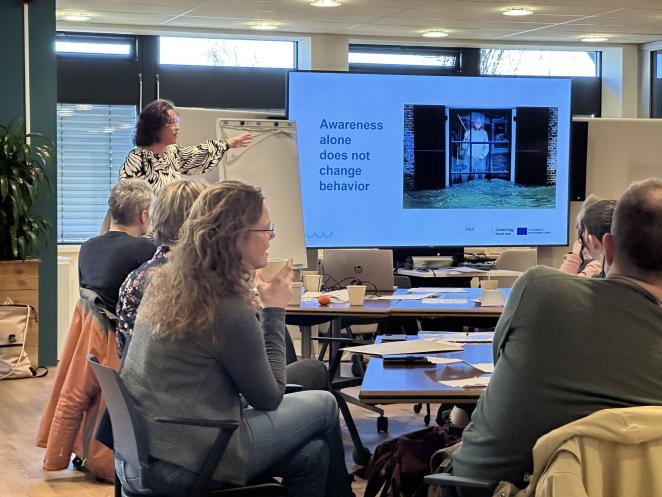During the partner meeting in Dordrecht, the FIER partners took part in a valuable behavioural change workshop, led by Patty Kanselaar from Dordrecht. The city’s extensive experience in engaging citizens for flood risk management provided the perfect backdrop for exploring how to encourage real behavioural change in flood preparedness.
Bridging the Gap Between Knowing, Wanting, and Acting
A key insight from behavioral science was shared by Kanselaar: “There is often a significant gap between knowing, wanting, and acting. While many citizens are aware of flood risks, they often fail to follow through with actions”. Behavioral science shows that factors such as habit, perceived effort, uncertainty, and lack of immediate rewards often prevent people from acting, even when they have the intention to do so. Kanselaar highlighted that achieving meaningful behavioural change requires more than just raising awareness. Even when all the necessary tools and information are available, people often still don’t take action. This means that support sometimes have to go beyond simply offering resources, it also involves understanding and addressing the psychological and contextual barriers that prevent people from acting.

Applying the CASI method for behavioural change
During the workshop, partners worked in small groups, each focusing on a different work package. They started by defining a specific target behaviour they wanted to promote. Next, they mapped out the behavioural factors that influence this behaviour, such as practical barriers, emotional responses, social norms, and habits. They did this by using the CASI (Communication and Action for Sustainable Impact) method to map out the behavioural factors that influence this behaviour. CASI is a structured approach, commonly used by governments including the Dutch government, to design behaviour change interventions that are both evidence-based and action-oriented. It helps practitioners link behavioural insights to practical tools like communication campaigns, environmental changes, or nudges.
By applying the CASI method, the partners were able to better identify what needs to be addressed in order to drive effective and lasting behavioural change. This collaborative process provided valuable insights into how to design interventions that combine communication with actionable steps to encourage positive change.

Practical tools for behavioural change
Through the workshop, partners gained practical tools and strategies to apply within their own work packages. They explored how to tailor interventions to specific target groups and design communications that would resonate and motivate citizens to take action on flood preparedness. With these new insights, partners are now better equipped to implement effective, actionable strategies that will drive positive change in their communities, helping everyone to be more prepared, more resilient, and above all: Be Ready, Be FIER.
